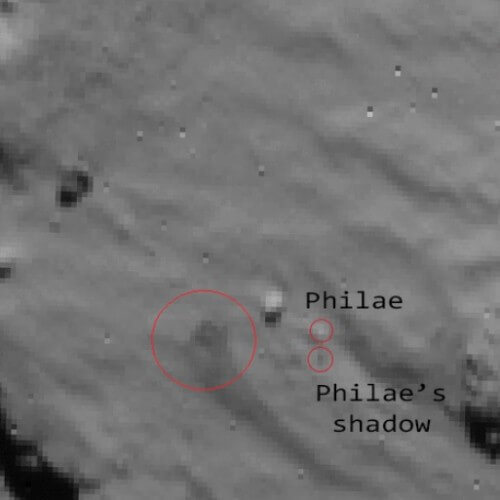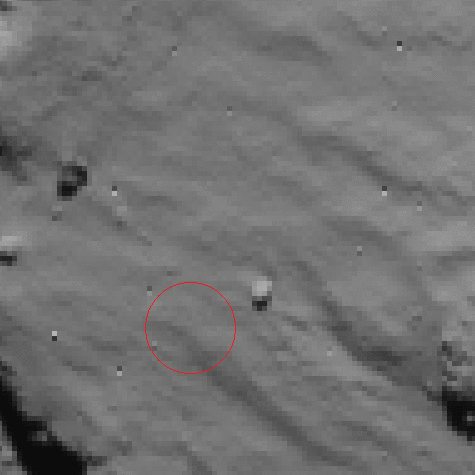\Philae's jump was captured by the Rosetta camera. The same analysis of the images also revealed the final whereabouts of the lander

The Rosetta spacecraft photographed Philae and Saliva shortly after it touched down for the first time with the comet 67P Churimov-Gersimenko. and immediately jumped. The first photo was taken on November 12 at 15:30 PM GMT and the second five minutes later. Photo: ESA/Rosetta/NAVCAM; pre-processed by Mikel Canania
When the Philae lander arrived at comet 67P Churimov-Grasimenko, which was its target, the small lander landed three times in two hours before reaching the resting place. While the flight controllers could understand this data from the data that was fed to them, they had no photographic proof - until now.
The animation presented here, a close-up of Rosetta images already published last week, showed Philae's shadow at the start of the liftoff, shortly after landing on November 12. Philae's first jump lasted almost two hours and then landed, hovered for several minutes and landed in a shady spot, and therefore she was unable to recharge the battery by converting solar energy and on Friday went into hibernation when the batteries ran out.
The wisdom of crowds plays an important part in deciphering the images. And this is what the European Space Agency wrote on the Rosetta blog: "Credit for the discovery goes to Gabriele Bellei of the Interplanetary Division at Flight Dynamics, who spent hours carefully examining Philae's navigation camera to look for evidence of a landing.
After the photos were published, a reader of the blog named John Broughton posted a comment reporting that he had spotted the lander in these photos. This sparked a debate in the comments section of the blog, and some wondered which of the formations could be attributed to the lander. Three of the readers named Martin Esser, Henning, and Kasoha were the first to add insight to the observation and many joined in afterward.
And last but not least, an independent and careful examination of the images by Mikel Kanania, of the Earth Observations Division at Flight Dynamics came to the same conclusion. He also made the labeled animation we see here.
This case proves that, despite the disappointment that Philae went into hibernation (perhaps permanently) earlier than scientists expected, the data it sent will continue to undergo analysis in the months and years to come, and we must not forget that Rosetta itself, the orbiter of the comet is in good condition and will continue to transmit data from 67P Churimov-Grasimenko while Approaching the Sun during 2015.

To the article on the Universe Today website
Landing on the comet - special coverage from Darmstadt on the Hidan site
- Philae completed her initial mission and went into forced hibernation
- Philae landed on her side, still sending impressive pictures
- Philae settled on a rocky surface but did not anchor to the ground of the comet
- Assessment as to the cause of the disruptions: Philae landed, then took off again and landed at a different point

8 תגובות
In the wisdom of crowds we are always amazed by the results.
Can anyone guess what is the reason for the same results?
This is not the wisdom of crowds.
In this particular case a few individual hobbyists discovered the solution before the European experts succeeded. The wisdom of the masses speaks of the fact that no one knows if his answer is correct, but a statistical combination of all the answers will give a more accurate answer over time than any single detail.
Yossi Simon
Rosetta, Pleia and also the comet are in equilibrium in an elliptical orbit. The fact that Rosetta is in orbit around the comet shows that its gravitational pull is not negligible.
After the separation of Philae from Rosetta, Rosetta was apparently not designed to control and transfer controls towards the flight path of Philae, so it is interesting that after the first jump, in which Philae rose to a height of 1500 meters (as reported) and stayed for about two hours in space, she kept the path of the comet's movement which during this time passed a huge distance in an apparently elliptical orbit. It must be remembered that the force of gravity between the comet and the lander is zero, and its diameter is only 5 km.